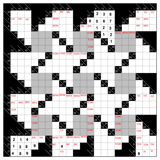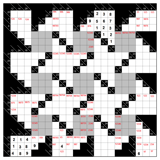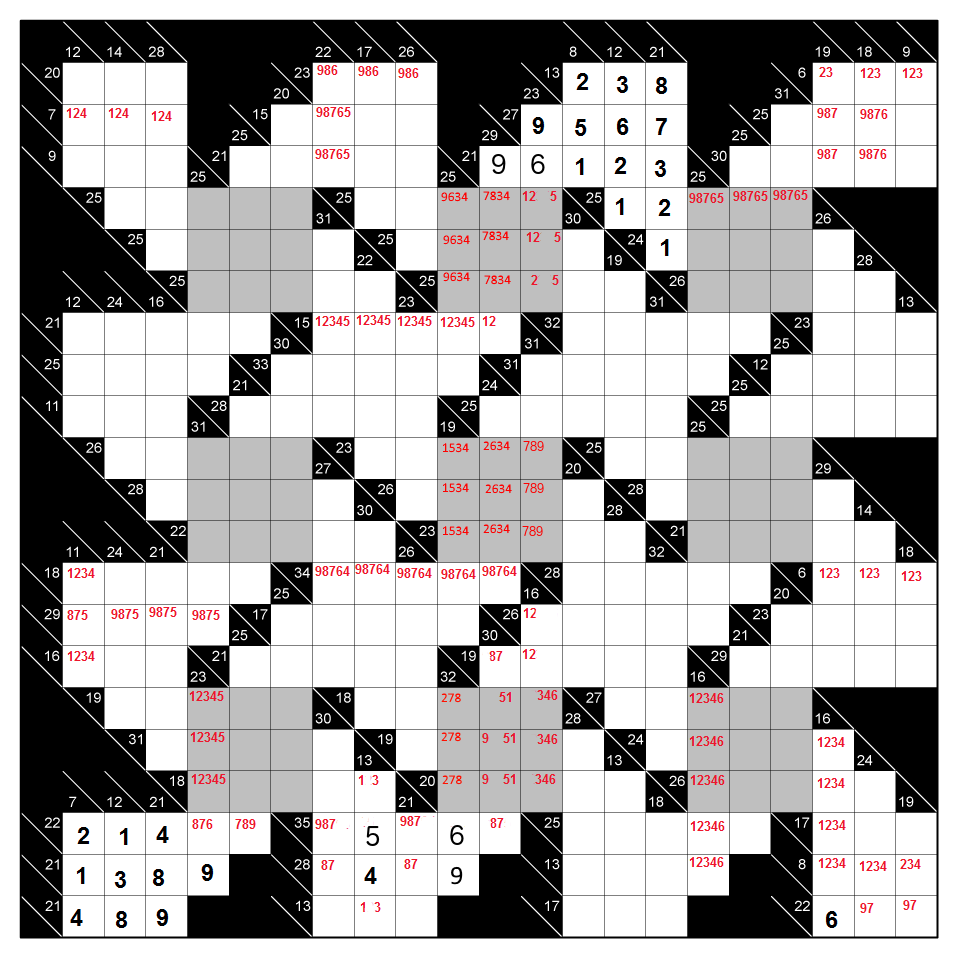Consider the bottom left chunk. 7 in three must be {1,2,4}, so the very bottom left cell must be 4 (1 or 2 can't be part of 21 in three) and the two above it are {1,2}. Also, the two to the right of it must be {8,9}.
If the middle one is 9, then the two above that are {1,2}, so the second-to-bottom row starts with {1,2}, contradiction. So the bottom row is (4,8,9), and we can swiftly fill in the rest of this little rectangle to get:

A couple more random deductions. Firstly, consider the bottom right chunk. 16 in five must be {1,2,3,4,6}, and nothing smaller than 5 can be part of 22 in three, so the bottom left cell of this chunk must be 6.
Secondly, consider the bottom second-to-left chunk. 35 in five must be {9,8,7,6,5}, and 9 or 8 can't be part of 13 in four. So the second cell of that 35 in five must be 7, 6, or 5; then the rest of the 13 in four is respectively {1,2,3}, {1,2,4}, or {1,3,4}. But nothing smaller than 4 can be part of 28 in four, so the second cell of that 13 in four must be 6 or 5 and the third must be 4.

Now let's add in a load of little red numbers for possibilities: where we don't know a cell's value for definite, but we can get it down to five or fewer possibilities. Most of these are quite trivially deduced: 6 in three is {1,2,3}, 7 in three is {1,2,4}, 8 in three is {1,2,5} or {1,3,4}, that kind of thing. (Leave a comment if there are any deductions you don't get in this bit, and I'll explain them better.)

As excellently deduced by Karan Atree (see their answer for the details), the top second-to-right chunk can be entirely filled. After getting as far as Karan's answer did in that chunk, we can fill in a few more possibilities in red close by:

Consider the upper right grey block. Clearly 1 can't be in either of its top two rows, so there must be a 1 somewhere in its bottom row. This means 1 can't appear in the bottom row of either of the other two upper grey blocks.
In the upper middle grey block, the right-hand column must be {1,2,3} or {1,2,4} or {1,2,5} or {1,3,4}. Either way, we must have a 1 somewhere in this column (and therefore in one of the upper two cells). This means 1 can't appear in the right-hand column of the centre grey block or of the lower middle one.
Similarly, in the lower left grey block, the left-hand column must be {1,2,3} or {1,2,4} or {1,2,5} or {1,3,4}. Either way, we must have a 1 somewhere in this column, so 1 can't appear in the left-hand column of either of the other two left grey blocks.
In the lower middle grey block, the 1 can't be in the left-hand column (1 can't be part of 32 in five) or in the right-hand column (by above), so it must be in the middle column, and that 30 in five is {9,8,7,5,1}. After all this Sudoku-ing, we have:

As argued by Jay in their answer, in the sixth column of the Sudoku block, the top three cells must be among 1,2,3,4,5 and the bottom three must be among 2,3,4,6, so the middle three must be {7,8,9}. Thus 1 and 5 must be somewhere among the top three, which means they are {1,2,5} and the cell above them is 6, with the one to the left of it being 9.
In the fifth column of the Sudoku block, the top three cells cannot be 9 (since there's a 9 just above them) and neither can the middle three (since 9 is on the right of the centre grey block) or the seventh (since it's part of 18 in five). So one of the bottom two cells must be 9, and whichever it is can't have 6 next to it.






















